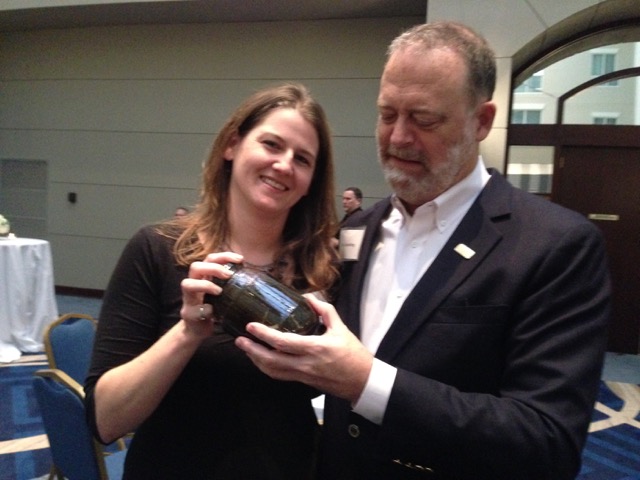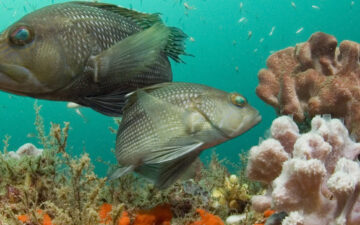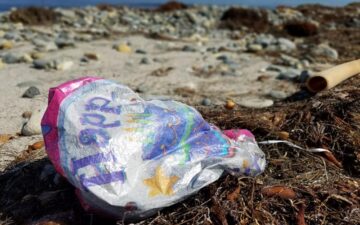By Mark J. Spalding, President
Earlier in December 2014, I was fortunate to be able to attend two very special events in Annapolis, Maryland. The first was the awards dinner of the Chesapeake Conservancy where we heard an impassioned speech from the organization’s E.D., Joel Dunn, on how important it is to believe that we all can help make the six-state Chesapeake Bay watershed a healthier place to live, work, and play. One of the evening’s honorees was Keith Campbell who told us that the facts support everyone who believes that a healthy Chesapeake Bay is the critical part of a healthy regional economy.

The following evening, it was Keith and his daughter Samantha Campbell (president of the Keith Campbell Foundation for the Environment and former TOF Board member) who were celebrating the accomplishments of Verna Harrison, who is stepping down after a dozen years as Executive Director of the Foundation. Speaker after speaker recognized Verna’s passionate commitment to a healthy Chesapeake Bay over decades. On hand to help celebrate her career to date were former governors, current federal, state, and local officials, more than a dozen foundation colleagues, and of course, dozens of other people who devote their days to a healthier Chesapeake Bay.
One of the dedicated individuals at the event was Julie Lawson, director of Trash-Free Maryland, who carried her companion jar of water from the Bay. A close look revealed that it was not her drinking water. In fact, I was sorry to learn that anything was drinking or living in this water. As you can see from the picture, the water in the jar was bright green, as green as the day it was collected. A closer look revealed that in the sinewy strands of algae hung bits of plastic of different sizes. A magnifying glass would reveal even more and smaller pieces of plastic.
The sample she carried was collected in late November when two conservation organizations, Trash Free Maryland and 5 Gyres Institute, went out to collect water samples and net samples of debris in the Chesapeake. They invited Chesapeake Bay expert and EPA senior advisor Jeff Corbin to go along: In a later blog, he wrote: “I predicted that we wouldn’t find much. My theory was that the Chesapeake Bay is too dynamic, with its constant tides, winds and currents, as opposed to the somewhat quiet open ocean circulation patterns that can concentrate plastics pollution. I was wrong.”
Microplastics is the term used to describe the tiny particles of plastic that are now present throughout our ocean—the remnants of the plastic trash that makes their way into waterways and into the ocean. Plastics do not disappear in the ocean; they break down into smaller and smaller pieces. As Julie wrote recently about the Bay sampling, “Thousands of microbeads from personal care products and an overall plastic density estimated at 10 times the level found in the famous “garbage patches” of the world’s oceans. These tiny pieces of plastic absorb other petrochemicals such as pesticides, oil, and gasoline, becoming increasingly toxic and poisoning the bottom of the Bay food chain that leads to blue crabs and rockfish consumed by humans.”
The December publication of a five-year scientific sampling of the world’s oceans in PLOS 1 was sobering — “Plastics of all sizes were found in all ocean regions, converging in accumulation zones in the subtropical gyres, including southern hemisphere gyres where coastal population density is much lower than in the northern hemisphere.” The study’s the estimates of how much plastic is in the world’s oceans underscores how ingestion and entanglement are harming life in the ocean.
We could all do as Julie does and carry a water sample with us. Or we could embrace the message that we hear over and again from Trash Free Maryland, the 5 Gyres Institute, the Plastics Pollution Coalition, Beyond Plastic, Surfrider Foundation, and their many partners around the world. It is a problem people fundamentally understand—and the first question we are often asked is “How can we get the plastic back out of the ocean?”
And, at The Ocean Foundation, we have regularly received proposals from various organizations and individuals regarding removal of plastics from the ocean gyres where it has accumulated. To date, none of these have penciled out. Even if we can use his system to collect plastic from a gyre, then we still need to know how much will it cost to carry that waste to land and covert it to fuel in some fashion. Or, convert it at sea, and then carry the fuel to land where it is more likely to be used. The full cycle cost to go and seek the plastic, convert it to energy or make some other use of it far exceeds the value of any energy or other recycled product produced (this is even more so now that oil prices are in a slump).
While I am concerned that it will remain difficult to make removing plastic from the ocean financially viable (as a for profit business venture); I do support taking plastics out of our ocean. For, if we can remove a large quantity of plastic from even one gyre, that would be a wonderful outcome.
So my usual response is, “Well, we can start by doing our part to not let any more plastic get INTO the ocean while we figure out a way to economically remove plastic pollution from the ocean without doing any harm.” So as we approach New Year’s, perhaps these are some resolutions we can keep on behalf of the ocean:
- First, the one that is particularly challenging at this time of year: Limit the creation of trash. Then, dispose of all trash properly. Recycle where appropriate.
- Find alternatives to the plastic items that you rely on; and turn down single-serving packaging, straws, excess packaging, and other ‘disposable’ plastics.
- Don’t overfill trashcans and make sure the lid fits tightly—the overflow too often winds up in the street, getting washed into storm drains, and out into waterways.
- Do encourage smokers to dispose of their butts properly—it is estimated that one third (120 billion) of all cigarette butts wind up in waterways in the United States alone.
- Carry your water bottle and re-useable shopping bags with you—we use 3 trillion bags a year worldwide and way too many of them wind up as litter.
- Avoid personal care products that have “microbeads” – they have become ubiquitous in waterways and on beaches as they have become ubiquitous in toothpaste, facial washes, and other products over the last ten years.
- Encourage manufacturers and others to pursue additional alternatives—Unilever, L’Oreal, Crest (Procter & Gamble), Johnson & Johnson, and Colgate Palmolive are just some of the companies that have agreed to do so by the end of 2015 or 2016 (for a more complete list).
- Encourage the industry to continue to seek solutions to prevent plastic from getting into the ocean in the first place.







